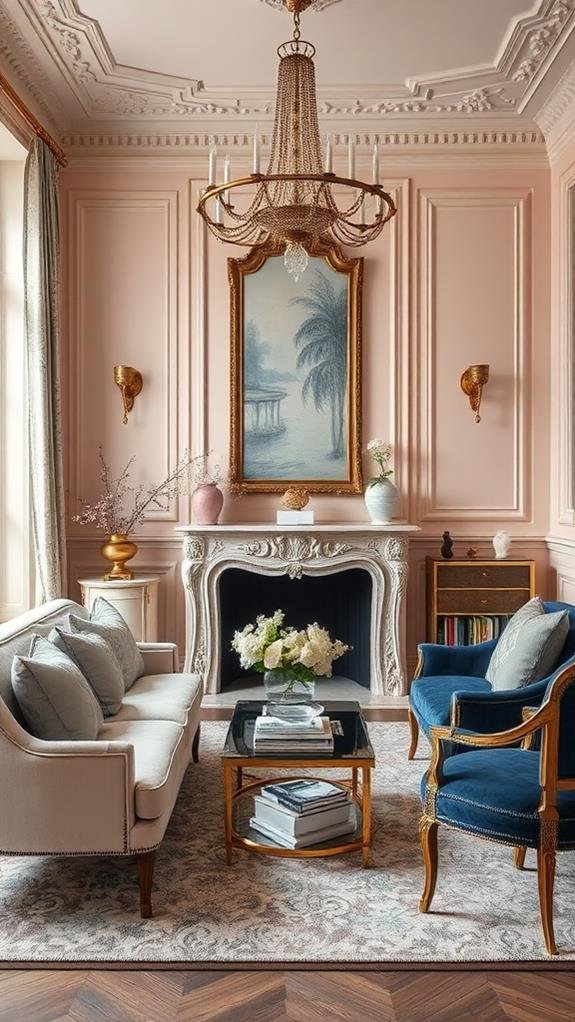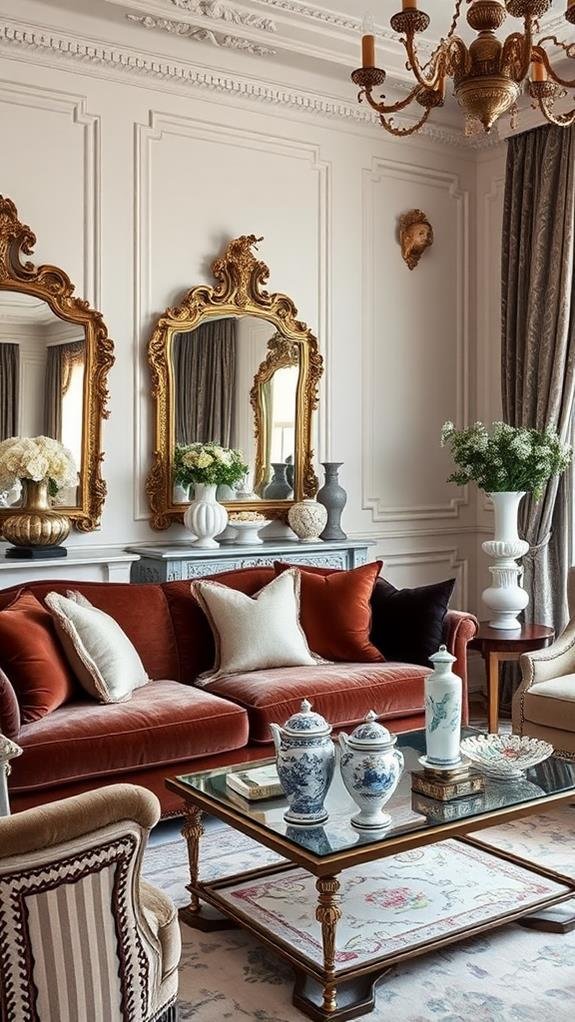7 Essential Elements in French Interior Design
To create a beautiful French interior, you’ll need to focus on seven essential elements. Start with a soft color palette using muted tones like creams and gentle blues, complemented by deeper accents. Mix furniture styles, combining traditional pieces with modern ones for charm. Incorporate rich textures and fabrics, such as linen and velvet, to add depth. Include architectural details like crown moldings for elegance. Choose warm lighting options, like chandeliers, to improve the ambiance. For decor, select art that reflects French culture, and don’t forget accessories like vintage mirrors to complete the look. There’s so much more to investigate!
Key Takeaways
- Soft, muted color palettes create a calming atmosphere, enhanced by deep accents for drama and unity.
- A blend of traditional and modern furniture styles brings unique charm and character to interiors.
- Textures such as linen, silk, and velvet add warmth and depth, fostering a cozy ambiance.
- Architectural details like crown moldings and arched doorways contribute elegance and balance to spaces.
- Thoughtful lighting choices, including chandeliers and warm bulbs, enhance mood and highlight decor.
Color Palette

With regard to the color palette in French interior design, balance and sophistication are key.
You’ll often find soft, muted tones like creams, pale blues, and gentle grays, which create a calming atmosphere. These colors work together harmoniously, giving your space a warm and inviting feel.
Accent colors, such as deep navy or rich burgundy, can add a touch of drama without overwhelming the room.
When choosing your palette, think about how the colors relate to each other and how they influence the space’s mood.
Natural light plays an important role, too, as it can change the colors throughout the day.
Emphasizing unity and elegance in your color choices will help create a stunning French-inspired space.
Furniture Styles

French interior design is renowned for its diverse furniture styles that merge elegance with functionality.
You’ll find a mix of traditional and modern pieces, each bringing its unique charm to your space. For example, Louis XVI furniture features clean lines and neoclassical detailing, while the more opulent Rococo style dazzles with intricate carvings and curved shapes.
If you prefer a touch of rustic beauty, consider French country furniture, which welcomes simplicity and warmth with distressed wood finishes.
Don’t forget about contemporary styles; they often blend with traditional designs, making your interior inviting yet chic.
Textures and Fabrics

When designing your space, the right textures and fabrics can improve the overall aesthetic, complementing the beautiful furniture pieces you’ve chosen.
Fabrics like linen, silk, or velvet add depth and warmth, creating an inviting atmosphere. You might think about mixing these materials; for instance, pairing soft velvets with crisp linens can create a lovely contrast.
Don’t forget about patterns—striped or floral designs can bring character and charm to your home. Additionally, adding textures like a silky throw pillow or a textured rug can make your space feel cozy and comfortable.
Always remember, layers matter! Combining different textures not only enriches your decor but also turns your home into a stylish retreat bursting with personality.
Architectural Details

Architectural details play an essential role in establishing the character of your space. These elements can include elegant crown moldings, ornate door frames, and decorative ceiling medallions.
To create that classic French look, focus on symmetry, which brings balance and harmony. You can also add arched doorways or tall windows to let in light and improve the feeling of openness.
Think about the overall structure—exposed beams in a rustic dining room or a carved fireplace mantel can add charm and sophistication. Incorporating elements like wainscoting or intricate paneling not only showcases craftsmanship but also adds depth to your decor.
Lighting Choices

Choosing the right lighting is crucial for achieving that quintessential French ambiance in your home.
Begin by considering a mix of overhead lights, wall sconces, and table lamps to create a warm glow. Chandeliers, especially in dining areas, add elegance and a touch of glamour.
Don’t forget about using dimmers; they let you adjust the brightness, setting a cozy mood for intimate dinners or lively gatherings.
You might want to opt for soft, warm bulbs that mimic candlelight, enhancing that romantic vibe.
Natural light is just as vital, so verify your windows are unobstructed, allowing sunlight to dance across your space.
Combine these elements, and you’ll find your home radiates the charm and sophistication of classic French design.
Art and Decor

Art and decor play a pivotal role in creating an authentic French aesthetic within your home. To achieve this, think about incorporating paintings, sculptures, and decorative pieces that reflect French culture and history. Choose artwork that speaks to you, whether it’s a classic landscape or a modern piece.
Don’t forget about frames; ornate gold or vintage styles elevate your displays beautifully.
Add wall hangings like tapestries, which bring warmth and texture to your space. Try to select colors that complement your furniture and lighting, creating a cohesive look.
Accessories and Accents

The charm of French interior design often lies in the careful selection of accessories and accents that uplift a space.
To truly adopt this style, think about adding decorative items like vintage mirrors, elegant vases, and chic throws. These pieces not only improve aesthetics but also reflect your personality.
Don’t forget about lighting; a beautiful chandelier or stylish sconces can create a warm atmosphere. Incorporate textiles with rich patterns or soft colors to add comfort and depth.
You can also use books and art to tell your own story within the room, showcasing your interests.
Remember, each element should blend harmoniously, creating a balanced look that feels both welcoming and distinctly yours.
This is what brings the essence of French style alive!
Conclusion
To sum up, embracing these seven essential elements of French interior design can transform your space into a cozy and stylish retreat. By carefully selecting your color palette, furniture, textures, and lighting, you create an inviting atmosphere. Don’t forget to add those personal touches with art and decor, along with thoughtful accessories. Remember, the key is to balance elegance and comfort, allowing your personality to shine through. So, get inspired and start designing your own French-inspired haven today!


